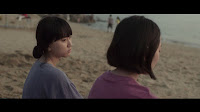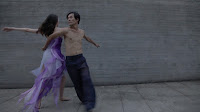Dernière mise à jour : août 17th, 2016 at 05:45 pm
The festival is coming to its end. With a very rich programmation and interesting conferences taking place in such a short time, it’s a pity that this charming festival doesn’t (yet?) occur on more days. On all the numerous films that I saw, three sections in particular have made an impression on me, which is why I chose to focus the next posts.
… sauf que neuf autres plans-scènes suivent, et l’on se rend compte vers la moitié que le film nous montre le récit, à l’envers, de l’arrestation arbitraire d’une jeune femme innocente, de son jugement expédié et de son injuste exécution. Ces étapes sont vus comme une entreprise de déshumanisation qui frappe de préférence les petites gens en les considérant comme des nuisances qui méritent la mort. Pourtant, de par sa construction en flash-back, le film se “réchauffe” à mesure que l’on en découvre davantage sur la jeune femme, chef d’orchestre dans une formation musicale locale et mère de famille. Dans le plan final, on la voit cuisiner chez elle tandis que son mari s’occupe de leur bébé. Ce moment d’intimité pure conclut le film sur une note de profonde mélancolie, où le fait que l’on ne voit pas les visages de son mari et de son bébé accentue leur perte. Glaçant et virtuose.
Extrait de “Killing the Chickens to Scare the Monkeys” de Jens Assur
Les autres films de cette section Compétition n°10 étaient :
“After” (Lukasz Konopa) : des groupes de touristes visitent un ancien camp de concentration et se prennent en photo devant les rails qui amenaient les prisonniers et les barbelés sadiques qui réduisaient leur horizon sans le leur masquer. Cet aspect touristique entre en contraste avec le travail de mémoire effectué par les employés qui rénovent les centaines de chaussures trouvées sur les lieux, et avec celui plus personnel du groupe de Juifs qui entonne une prière à la mémoire de leurs parents victimes de l’holocauste. À la fin, le geste anodin d’un employé vidant les poubelles choque presque dans sa banalité, qui s’inscrit dans ce lieu rempli des pires horreurs.
“Graduation Trip” (Park Seon-ju) : chronique adolescente sur deux lycéennes dont l’une est secrètement amoureuse de l’autre. Elles mentent à leurs parents (audace, aventure, tentation de l’interdit) pour se rendre à un festival de rock, mais rien ne se passe comme prévu et leur amitié est mise à l’épreuve. Deux scènes de métro, au début et à la fin, mettent le film entre parenthèses. Dans la première, une fille prend son amie en photo ; dans la dernière, c’est l’inverse. Comme un transfert de désir.
| “Flamingo Pride” (Tomer Eshed) : sorte de gay pride dans la savane avec des animaux en images de synthèse. Un flamand rose tombe amoureux d’une cigogne mais ne sait pas comment se déclarer. Extrêmement drôle et bien animé. |
“A pale purple bird” (Oh Kwang-rok) : film expérimental sur la danse et langage des corps. Très inattendu et émouvant. Lorsque la scène finale, fictionnelle, intervient, elle paraît d’abord de trop. Mais un dernier regard d’elle à lui, et de lui au ciel, apporte un sentiment prégnant de promesse.
À suivre..
Sébou/세부
En savoir plus :
– CINEMA: BISFF 2012 ;
– http://www.bisff.org (site officiel).
… except there are nine other long-shots coming, and we soon realize that the film tells us the story in reverse, from the arbitrary arrest of an innocent young woman, to her expedited trial until her unjust execution. Those steps are seen as an dehumanizing process whose privileged victims are the simple folks, considered as nuisance that deserve death. Yet, thanks to its flash-backs structure, the film “warms up” somehow as we learn more about the woman, a conductor in a local orchestra and a young mother. In the last shot, she’s shown cooking while her husband is taking care of their infant. That moment of pure intimacy concludes the film on a profound melancholy; the fact that we don’t see the man and baby’s faces only makes their loss more painful. Bone-chilling and virtuoso.
Excerpt from “Killing the Chickens to Scare the Monkeys” by Jens Assur
Other films in this section Competition No. 10 were:
“After” (Lukasz Konopa): groups of tourists visit a former concentration camp and take pictures in front of the track that brought prisoners and in front of the barbed sadists who reduced their horizon without masking it. This aspect of tourism enters in contrast with the memory work performed by employees who are renovating the hundreds of shoes found at the scene, and with the more personal one of Jews group who sings a prayer in memory of their parents victim of Holocaust. At the end, the harmless act of an employee emptying garbage cans is almost shocking in its banality, which is taking place in this place full of horrors.”After” (Lukasz Konopa): groups of tourists visit a former concentration camp and take pictures in front of the track that brought prisoners and in front of the barbed sadists who reduced their horizon without masking it. This aspect of tourism enters in contrast with the memory work performed by employees who are renovating the hundreds of shoes found at the scene, and with the more personal one of Jews group who sings a prayer in memory of their parents victim of Holocaust. At the end, the harmless act of an employee emptying garbage cans is almost shocking in its banality, which is taking place in this place full of horrors.
“Graduation Trip” (Park Seon-ju): teenager chronic on two schoolgirls, with one of them is secretly in love with the other one. They lie to their parents (daring, adventure, temptation of the forbidden) to go to a rock festival, but nothing goes as they planned and their friendship is tested. Two scenes of subway, at the beginning and at the end, put the film in interludes. In the first one, a girl takes a picture of her friend and in the latter one, it is the opposite. Like a transfer of desire.
| “Flamingo Pride” (Tomer Eshed): a sort of gay pride in the savannah with computer graphics animals. A flamingo falls in love of a stork but does not know how to declare himself. Extremely funny and well animated. |
“A pale purple bird” (Oh Kwang-rok): experimental film on dance and body language. Very unexpected and moving. When the final scene, fictional, arrives, it seems at first too much. But a last look from her to him, and from him to the sky, brings a sense of pregnant promise.
To be continued..
Sébou/세부
To learn more:
– CINEMA: BISFF 2012 ;
– http://www.bisff.org (official website).
 Bulles de Culture Sur Bulles de Culture, chaque jour, la culture sort de sa bulle !
Bulles de Culture Sur Bulles de Culture, chaque jour, la culture sort de sa bulle !




